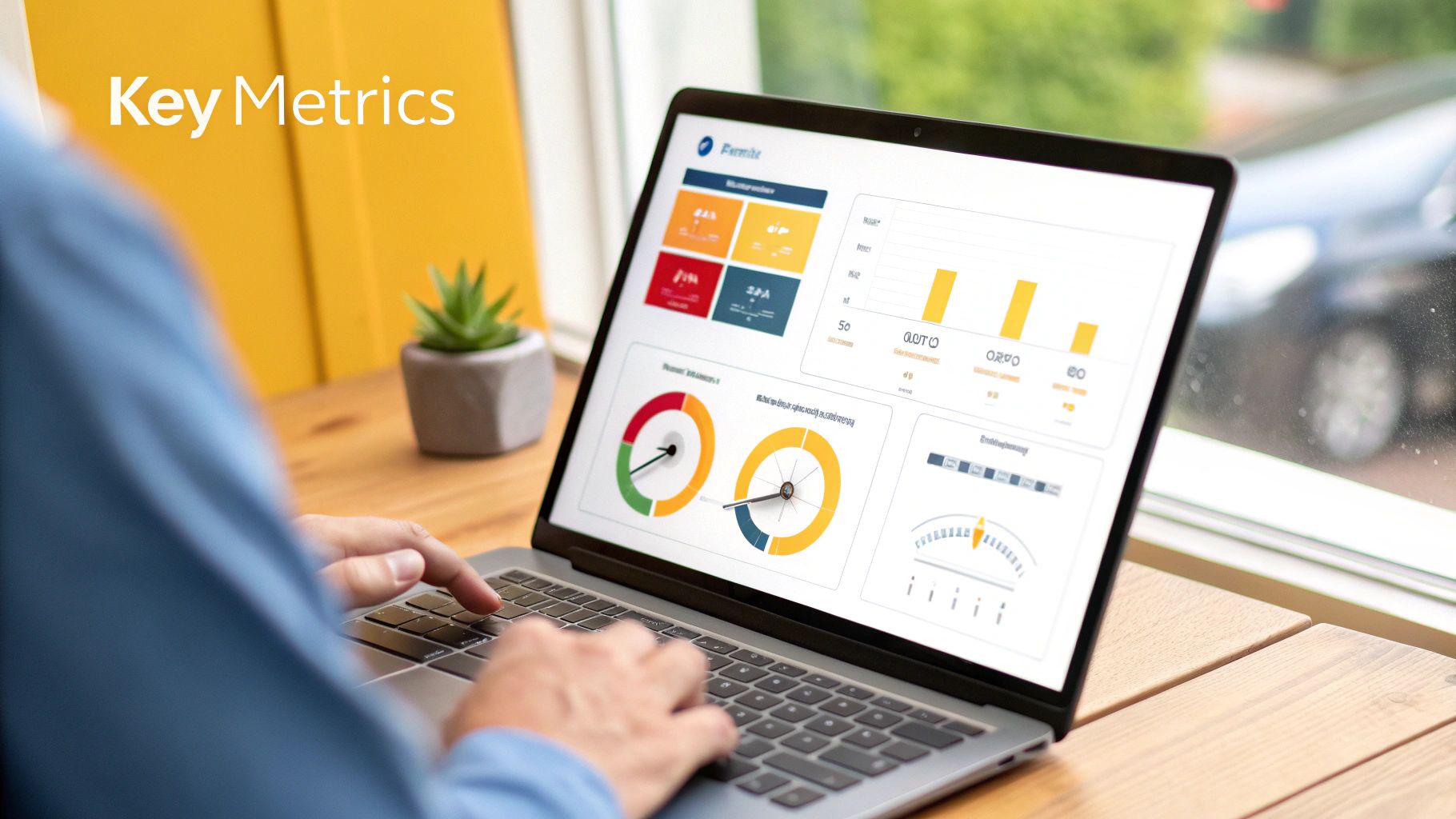Web Analytics for Beginners: Essential Strategies
Demystifying Web Analytics: What Really Matters

Web analytics dashboards can feel overwhelming to newcomers. Sifting through the sheer volume of data and pinpointing the truly valuable insights can be a challenge. This section simplifies the core components of web analytics for beginners, providing actionable advice from seasoned analysts.
Why Web Analytics Matters
Monitoring visitor behavior isn't just for large corporations. It's essential for websites of all sizes, from small businesses using Linkero to major enterprises. Understanding how users engage with your website provides crucial information about what content resonates with your audience.
This knowledge empowers you to refine your website, content, and marketing initiatives, ultimately boosting engagement and conversions. Imagine a bookstore owner discovering that customers frequently abandon their online shopping carts after adding a particular genre of books.
This information highlights a potential problem. It could be pricing, website navigation, or even the book selection itself. Armed with this data, the owner can investigate and enhance the customer experience. This exemplifies the practical power of web analytics. In today's competitive digital marketplace, data-driven decisions are a necessity.
Key Insights From Your Data
Web analytics provides valuable insights into what your visitors are seeking (and what they're not). It's akin to having a direct conversation with your audience, understanding their preferences, and adapting your website to meet their needs.
This data can unveil important patterns, such as:
- Popular content: Which pages or products are generating the most interest?
- User flow: How are visitors navigating your website?
- Pain points: Where are users experiencing difficulties or leaving the site?
These insights guide your optimization strategies. For instance, if analytics reveal users are struggling to locate your contact information, you can make it more prominent, potentially leading to increased inquiries and sales. Web analytics empowers you to make informed choices.
Rather than relying on guesswork, this targeted approach maximizes your resources and enhances your connection with your audience. A popular platform for web analytics is Google Analytics. As of 2022, it held a market share of 29.62% in the website analytics sector.
This widespread use is attributed to its robust features, including real-time data tracking, conversion analysis, and user behavior insights. Learn more at Bluehost.
Separating Signal From Noise
Not all metrics hold equal weight. Some are essential, while others are simply distractions. Distinguishing between actionable metrics (such as conversion rate and bounce rate) and vanity metrics (like page views without context) is crucial.
Concentrating on the right data allows you to identify what genuinely drives results, avoiding unnecessary distractions from irrelevant numbers. Even valuable metrics require proper context. A high bounce rate might indicate a problem with page content or website design.
However, it could also be perfectly normal if users are landing on a specific page to quickly find a specific piece of information. Understanding your website's purpose and typical user behavior is essential for accurately interpreting data. This nuanced approach to web analytics allows you to extract meaningful insights and utilize them for real growth.
The Only Metrics Beginners Actually Need to Track

As a beginner, navigating the world of web analytics can feel overwhelming. There's so much data available, it's easy to get lost. This section simplifies things by focusing on the most crucial metrics for beginners. These metrics offer real insights into your website's performance and how users behave. This allows you to make data-driven decisions without getting bogged down.
Understanding the Core Metrics
Forget about vanity metrics like total pageviews. Instead, concentrate on metrics that show how users actually interact with your website. Think of it like a physical store: you'd want to observe how customers behave inside, not just count how many walk through the door. Are they browsing specific areas, picking up items, or leaving right away? The same principle applies online.
To get started, focus on these key metrics:
Bounce Rate: This tells you the percentage of visitors who leave your site after viewing only one page. A high bounce rate could signal problems with your content, design, or overall user experience. However, a high bounce rate isn't always bad. For example, it can be perfectly normal if users land on a page with the single piece of information they were looking for.
Session Duration: This metric shows how long users stay on your site. Longer session durations generally indicate higher engagement with your content. A visitor spending several minutes on your blog is more engaged than someone who quickly clicks through to a product page and then leaves. This provides valuable context for optimizing your content length and format.
Conversion Rate: This measures the percentage of visitors who complete a desired action. This action could be anything from filling out a form to making a purchase. It's the ultimate measure of your website's effectiveness in achieving its goals. For instance, if you're aiming to grow your email list, a high conversion rate on your signup form indicates you're doing well.
To further clarify the importance of these metrics, let's take a closer look at them in a table format. The following table summarizes what each metric reveals, why it matters, and when you should consider taking action.
Essential Analytics Metrics for Beginners The metrics that actually matter, what they reveal, and when to take action
| Metric | What It Truly Reveals | Why It Matters to You | When to Take Action |
|---|---|---|---|
| Bounce Rate | Percentage of single-page visits | Indicates content relevance and user experience | High bounce rate with low conversion warrants investigation into site design and content. |
| Session Duration | Length of user visits | Shows user engagement and content effectiveness | Short durations may indicate content issues or navigation problems. |
| Conversion Rate | Percentage of completed desired actions | Measures website effectiveness in achieving goals | Low conversion rates require analysis of the sales funnel and user journey. |
This table helps illustrate the relationship between these key metrics and how they contribute to understanding your website's performance. By monitoring these metrics, you can identify areas for improvement and optimize your site for better results.
Why Context is Crucial
Analyzing metrics in isolation can be misleading. A low bounce rate might seem good, but if your conversion rate is also low, it's not a true indicator of success. Similarly, a long session duration isn't valuable if users aren't converting. Always interpret these metrics together and consider your specific website goals and target audience. Understanding industry benchmarks can also help you set realistic expectations for your website's performance. You might be interested in: How to master your sitemap.
Setting Up for Success
Choosing the right metrics is the first step. Next, you need to set up your analytics platform correctly. This includes proper configuration and goal tracking aligned with your business objectives. This foundation ensures accurate data collection and insightful analysis. By focusing on the right data, you can quickly gain valuable insights and make informed decisions to improve your website's performance.
Setting Up Google Analytics Without the Headaches

Now that you understand the core metrics of web analytics, the next step is setting up your analytics platform. This is crucial for accurate data collection and analysis. This section will guide you through setting up Google Analytics, a popular and powerful tool, in a simple way.
Getting Started With Google Analytics
Setting up Google Analytics might seem complex, but with the right approach, it can be straightforward. The first step is creating a Google Analytics account and obtaining your tracking ID. This unique identifier links your website to Google Analytics.
Think of your tracking ID as your website's individual fingerprint within the platform. It allows Google to collect and analyze data specifically for your site. Once you have your tracking ID, you'll need to install it on your website.
Platform-Specific Installation
Installing your tracking ID depends on your website platform. Here’s a quick breakdown:
- WordPress: Many WordPress themes have built-in areas for tracking codes. Plugins like Insert Headers and Footers also simplify the process.
- Shopify: Shopify usually offers dedicated fields within its settings for adding analytics tracking codes. This simplifies integration.
- Wix: Similar to Shopify, Wix generally has designated areas in its settings to add external tracking codes.
- Other Platforms: For other platforms, you’ll likely need to add the tracking code to your website's header or footer within your site’s code files.
Accurate installation is key, regardless of your platform. Double-check your installation to ensure data is collected correctly from the beginning and avoid issues like misplaced code.
Organizing Your Google Analytics Account
Organizing your Google Analytics account is important for long-term success. This involves setting up views and filters. Views are like different perspectives for your data.
You might create one view for all website data and another that excludes internal traffic. Filters refine your data by removing unwanted traffic, such as bots or specific IP addresses.
Setting Up Meaningful Goals
Goals in Google Analytics help you track conversions: the actions you want visitors to take on your website. Examples include form submissions, purchases, or downloads. Aligning your goals with your business objectives is crucial.
For example, if your goal is to increase newsletter sign-ups, you’d create a goal to track form submissions on your newsletter signup page. This allows you to measure the effectiveness of your efforts. Learn more in our article about How to master your sitemap.
Privacy Considerations
Data privacy is essential. Familiarize yourself with regulations like GDPR and CCPA. Ensure your data collection practices are compliant, including providing clear privacy policies and allowing users to opt out of tracking. This builds trust with your audience. By following these steps, you can effectively set up Google Analytics and gather valuable data to inform your website strategies.
Turning Raw Numbers Into Actionable Insights
So, you've got Google Analytics set up and data is flowing in. That's a great first step! However, raw data alone won't get you far. The true power of web analytics lies in transforming these numbers into actionable strategies to enhance your website. This section will show you how to interpret your data, identify meaningful patterns, and use those insights to make impactful website improvements.
Developing Your Analytical Mindset
Web analytics is a bit like detective work. You're searching for clues to understand user behavior on your site. Don't just look at individual metrics in isolation; instead, connect the dots between different data points to uncover the story they tell.
For instance, if you notice a high bounce rate on a particular landing page coupled with a low average session duration, this might indicate the page isn't meeting user expectations. This insight can then inform improvements to the page's content, design, or call to action.
Experienced analysts often identify hidden patterns by segmenting their audience. This involves dividing your website visitors into groups based on shared characteristics like demographics, traffic source, or on-site behavior. For example, segmenting by traffic source could reveal that visitors from social media have a much lower conversion rate than those from organic search. This then highlights specific areas for improvement, like refining your social media targeting or tailoring your landing pages for different traffic sources.
Building Simple, Effective Dashboards
Dashboards play a crucial role in visualizing important data. Rather than sifting through mountains of numbers, a well-designed dashboard presents key metrics at a glance. As a beginner, create a simple dashboard that tracks the metrics directly related to your website's goals.
If your primary goal is lead generation, for example, your dashboard might prioritize metrics like conversion rate, form submissions, and lead quality. Start with a few key performance indicators (KPIs) and gradually add more as you become more comfortable analyzing the data.
Using Insights to Drive Decisions
The real value of web analytics comes from using the data to inform real-world action. Successful website owners leverage these insights to make informed decisions in three core areas:
- Content Strategy: Understanding which content performs well helps you create more of what resonates with your audience. This might include creating more blog posts, videos, or product descriptions similar to your top performers.
- User Experience Improvements: If your analytics reveal that users are struggling with navigation or experiencing technical difficulties, you can pinpoint the problem areas and implement targeted fixes.
- Marketing Adjustments: Analyzing campaign performance across various channels allows you to optimize your marketing spend and focus on the most effective strategies.
Statistical knowledge is also essential for accurately interpreting web analytics data. Concepts like sample size and statistical inference are crucial for drawing reliable conclusions. Learn more about the role of statistics in web analytics here. By understanding these concepts, you can avoid making incorrect assumptions based on minor data fluctuations. Even small, data-driven improvements can significantly impact your website's overall success. The ongoing process of analyzing data, taking action, and refining your approach is key to continuous website improvement.
Troubleshooting Analytics: Solving Common Roadblocks

Even with a solid foundation in web analytics for beginners, challenges are inevitable. This section explores common roadblocks encountered by both beginners and seasoned analysts. We'll offer practical solutions and diagnostic techniques gathered from interviews with analytics professionals. By the end of this section, you’ll be prepared for real-world analytics troubleshooting.
Decoding The Mysteries: Common Web Analytics Problems
One of the most alarming issues is a sudden, unexplained drop in traffic. This could be due to a variety of factors. These range from technical issues on your website to changes in search engine algorithms. Even external factors like seasonal trends can play a role.
Another common problem is conflicting data between different analytics platforms. For example, your Google Analytics data might show different numbers than your website hosting platform’s built-in analytics. This discrepancy can make it difficult to get an accurate picture of your website’s performance.
Additionally, suspicious referral sources can skew your data. This often involves spam bots or irrelevant websites falsely reporting referrals. As a result, it becomes harder to identify genuine traffic sources. Finally, tracking gaps, where data isn't being collected properly due to incorrect setup or technical glitches, can lead to incomplete or inaccurate analysis.
Analytics Detective Work: Diagnosing The Root Cause
Identifying the root cause of these problems involves some detective work. For example, if you experience a traffic drop, start by checking for any recent changes to your website. These might include updates or redesigns. Also, investigate potential algorithm updates from search engines. Analyzing trends and patterns over time can provide a clearer view. Check out our guide on How to master your sitemap.
If you encounter conflicting data, carefully review the configuration of each platform to ensure you're comparing apples to apples. When dealing with suspicious referrals, examine the source of these referrals and filter out known spam sources. For tracking gaps, meticulously audit your tracking code implementation.
Practical Solutions and Workarounds
Once you've diagnosed the problem, implementing appropriate solutions is key. This might involve fixing technical errors, adjusting your tracking code, or filtering out unwanted data. This requires taking decisive action to remedy the issue.
To help you quickly diagnose and solve problems, we've created the following toolkit:
Analytics Emergency Toolkit: Diagnosing and solving the most frustrating analytics problems beginners encounter
| Problem You'll Face | Likely Culprits | Diagnosis Steps | Proven Solutions |
|---|---|---|---|
| Traffic Drop | Technical issues, algorithm changes, seasonality | Check website status, analyze search console data, compare traffic patterns | Fix technical errors, optimize for search engines, adjust marketing strategies |
| Conflicting Data | Different platform configurations, tracking discrepancies | Review platform settings, compare data collection methods | Standardize tracking, adjust platform settings |
| Suspicious Referrals | Spam bots, irrelevant websites | Analyze referral sources, filter out known spam | Implement filters, block suspicious domains |
| Tracking Gaps | Incorrect code implementation, technical glitches | Audit tracking code, test tracking across pages | Fix code errors, implement robust tracking solutions |
This table provides a starting point for tackling common analytics challenges. Remember to adapt these steps to your specific situation.
Mastering Data Sampling and Cross-Device Tracking
Two further challenges are data sampling and cross-device tracking. Data sampling occurs when analytics platforms analyze only a subset of your data to provide faster results. This is especially common with large datasets. However, this can sometimes lead to inaccuracies. Understanding how your chosen platform handles sampling is crucial for accurate interpretation.
Cross-device tracking is the ability to track a single user across different devices, such as their phone, tablet, and desktop computer. This is increasingly important in today's multi-device world. Understanding how your chosen platform handles both data sampling and cross-device tracking is essential for a complete view of user behavior. This knowledge allows you to make informed decisions and avoid misleading conclusions.
From Insights to Results: Making Data Drive Growth
Web analytics for beginners is about using data to make informed decisions that boost website performance. This section explores how data can fuel real growth.
Prioritizing Changes Based on Impact
Effective website owners use data-driven frameworks, not intuition, to guide changes. Analyzing web analytics pinpoints areas for improvement. A high exit rate on a product page, for example, signals a potential problem. Is the product description confusing? Are shipping costs prohibitive? Data prioritizes these improvements, avoiding random changes.
Building a Testing Culture
Website refinement is an ongoing process. Create a culture of testing and experimentation. A/B testing, comparing two webpage versions, is a powerful technique. Testing different headlines or calls to action reveals which version yields more conversions. Small, data-backed adjustments create significant improvements over time.
Communicating Findings Effectively
Data often needs to be presented to team members or clients unfamiliar with web analytics. Communicate clearly and concisely, emphasizing key takeaways and potential impacts on business goals. Visualizations like charts and graphs enhance understanding and engagement. Explain data simply, focusing on its impact on their bottom line, rather than using technical jargon.
Showcasing Real-World Successes
Case studies demonstrate how websites have leveraged data for improvement. A small business might use analytics to identify a key customer segment, tailoring marketing messages for increased sales. These examples illustrate the power and accessibility of web analytics.
From Small Adjustments to Big Wins
Small, strategic, data-driven adjustments can make a big difference. Improving website navigation clarity could create a 5% increase in conversions. Optimizing loading speed might decrease bounce rate by 10%. These seemingly minor improvements, when combined, significantly enhance performance and contribute to sustainable growth.
Want to improve your online presence and understand audience behavior? Linkero offers a platform to manage links and track performance with integrated analytics. Create a free account today and begin optimizing your online presence with Linkero!


